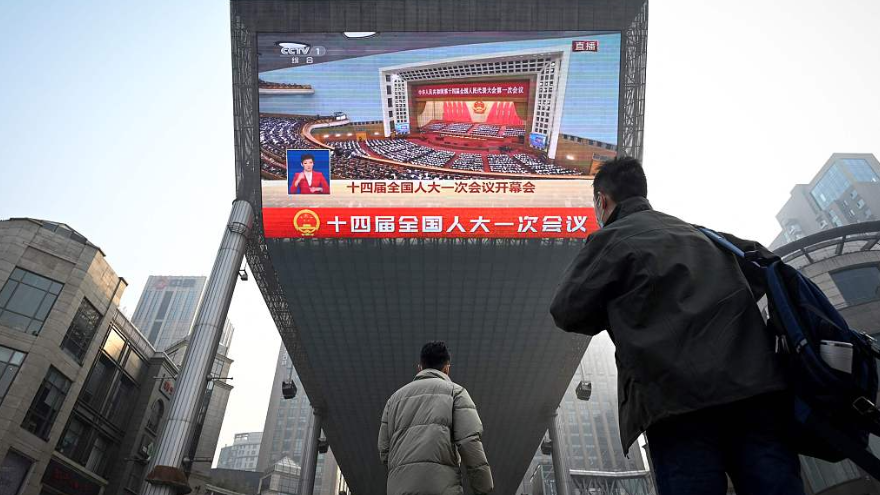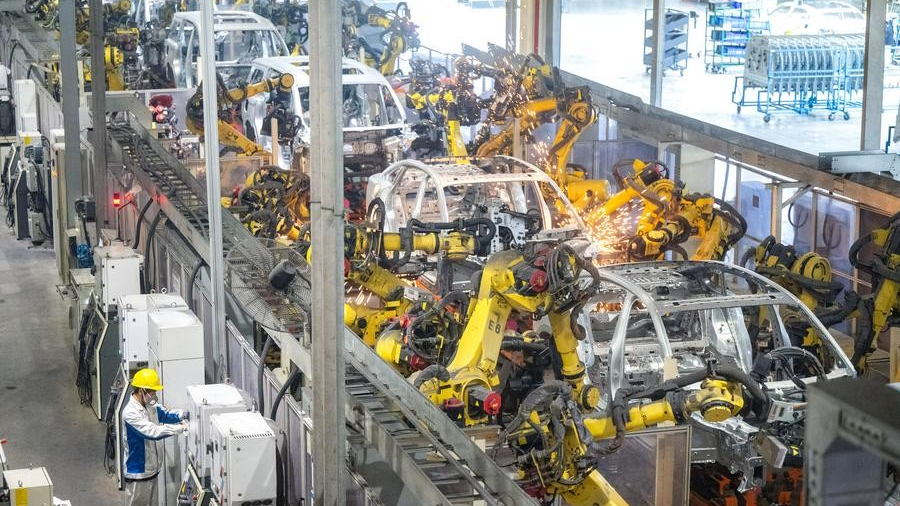【CGTN】夏璐等:China to set goals for years ahead
发布时间:2023-03-09
People watch live coverage of first session of the 14th National People's Congress on an outdoor screen in Beijing, China, March 5, 2023. /CFP
The first session of the 14th National People's Congress (NPC), China's top legislature, opened at the Great Hall of the People in Beijing on March 5. Chinese Premier Li Keqiang delivered the annual government work report to the NPC, which covered the past five year's achievements and laid out socioeconomic goals for the administration of the next term. China stands on track to build a "modern socialist country in all respects."
China's political season this year, including sessions of both the NPC and Chinese People's Political Consultative Conference, has attracted more attention, since it's the most important national political event after the pandemic. Meanwhile, China is carrying out the Chinese modernization blueprint that was introduced at the 20th National Congress of the Communist Party of China (CPC) last year.
Work and achievements in the past
Beijing's foremost mission is to advance the country's economic growth. It's challenging due to China's large land size and high population, as well as the country's complex domestic socioeconomic development. Numerous unexpected events and issues have made the tasks tougher.
The COVID-19 pandemic has haunted the country for three years. Yet, China holds pre-accumulated advantages for robust economic growth, but the long pause resulting from the pandemic has had a deep impact on economic activities. Many small and medium-sized enterprises have endured unforeseen challenges, which have increased unemployment and led to an economic slowdown.
From an international perspective, the same period has also witnessed deficits of peace, development, governance, and trust, causing global industrial chain disruptions. Accordingly, Beijing has served as a torchbearer with a wagon behind it when facing the storm and gale. The Chinese government has made a decisive victory over tackling poverty, with almost 100 million rural residents lifted out of extreme poverty over the past decade or so.
Other achievements are evidenced by the average annual GDP (gross domestic product) growth rate and consolidation of food security during the last five years, which had attested to the steadiness of China's macroeconomic policy.
Goals and schedules for years ahead
With the world entering a new era, China has more opportunities for economic recovery. But as a Chinese saying goes, "one can't eat hot bean curd in a hurry," goals and schedules for years ahead are made around the keyword "steadiness."
Tourists watch the New Year's Eve fireworks and light show at the Fantasy Valley park in Xiangyang, China, December 31, 2022. /CFP
China's deep reform remains on-going and the country is shifting the gears of its economic development. Accordingly, consolidating achievements have become more important than ever before. Hence in Premier Li's work report, the main expected economic growth targets for 2023 are: To include maintaining the annual GDP growth rate at 5 percent, creating 12 million new jobs in cities and towns while keeping the unemployment rate no higher than 5.5 percent, and holding down consumer prices by about 3 percent.
Compared with targets of previous reports, the ones for this year and the years ahead are not aggressive. The above three precise figures stand in accordance with the general principles proposed at the 20th National Congress of the CPC and Central Economic Work Conference shortly thereafter.
The key missions of the Chinese government in the years ahead also include carrying out an innovation-driven strategy and balancing development and security. China used to be a labor-intensive economy, which has brought "Made in China" global acclaim. As the competition among countries has shifted from whether there are enough manual labor resources to whether there are adequate and leading scientific and technological strength, Beijing has realized the urgency to adopt an innovation-driven strategy.
While China transforms from "Made in China" to "Designed in China," the Chinese will face stiffer competition and unforeseen pressures. As the late political scientist and economist Immanuel Wallerstein once argued in his famous world system theory, core countries (already industrialized ones) would rather maintain the status quo than allowing peripheral and semi-peripheral countries (catching-up ones) to rise up to the core level, since the former ones want to hold on to their dominance for as long as possible.
But there must be changes one way or another. For the 14th Five-Year-Plan in 2020, the mission is tough but that has also attested to the strong continuity of China's macroeconomic policy.
Editor's note: Xia Lu is an associate professor at the School of Marxism Studies and a research fellow at the National Academy of Development and Strategies, Renmin University of China. Gao Lei is an associate professor and research fellow at the Collaboration Centre for Theories and Practice of Open Economy, Center for Xi Jinping Thought on Opening-up, Research Institute of Globalization and China's Modernization, University of International Business & Economics.
原文链接:China to prioritize development with steadiness and continuity
作者:夏璐 中国人民大学国家发展与战略研究院研究员、马克思主义学院副教授








